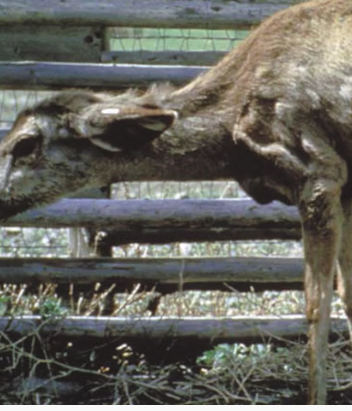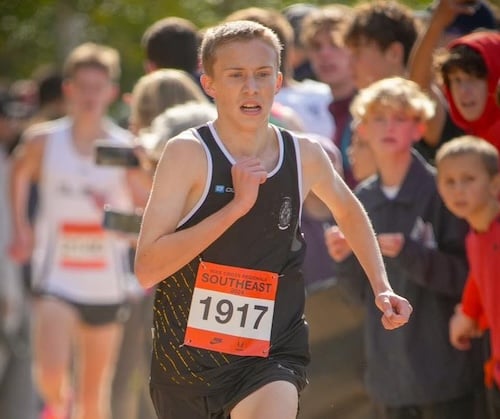Given the prestigious college offers Michael Mayer has already received, it’s a safe assumption the Covington Catholic High School football prodigy will go down as one of the most highly recruited players in Northern Kentucky history.
Notre Dame, Alabama, Ohio State, LSU and Nebraska are among the schools that are hoping to sign the multitalented Mayer, a 6-foot-5, 215-pound tight end. It’s not a matter of if he will play for a big-name program, just where.
What makes his recruitment even more impressive is the fact Mayer still has two years remaining in high school.

We both agreed you have to start the conversation with Shaun Alexander, the Boone County High School legend who went on to achieve national stardom at both Alabama and in the NFL. But after Alexander, it’s a real dilemma in choosing someone.
That is, until Mayer started getting all these offers. I suggested it might be fair to now consider the CovCath junior-to-be on the same level as the man known as “Alexander the Great” during his years at Boone County in the 1990s. My friend agreed and wondered who else would be in the conversation if we walked back in time, let’s say, the past 40 years.
So here is a list of players from those decades that might qualify, at least in my opinion. It’s all strictly subjective, though a great deal of research was needed to finalize the group. But we’re also hoping to hear from the readers. Email your thoughts to don@nkytrib.com, and I will tabulate the results later this spring. We will publish the final numbers sometime in May.
Please keep in mind this is not projecting Mayer as a can’t-miss college All-American or potential NFL star. While he could eventually be the next Tony Gonzalez as an NFL tight end, it’s too early to make those judgments. We can’t see the future in Mayer’s case, but we can view the past accomplishments of the other members of this list. Everyone on this list, obviously, played at so-called “Power 5” conference schools. Any success they had in college or the NFL is irrelevant to making this list, but I did include those accomplishments for each player. It’s interesting to see how their careers varied after high school, as all were highly recruited by major football programs from around the nation.
For now, here are my selections — “Northern Kentucky’s Great Eight” is what I’m calling them — beginning with the most renowned running back in this region’s history. The years in which each player competed at the varsity level are in parenthesis.

Alexander’s eye-popping numbers against Campbell County earned him a place in the “Faces in the Crowd” section of Sports Illustrated several weeks later, giving the Boone County star national publicity. And it would not be the last time Alexander gained national attention.
After rushing for 3,166 yards and 54 touchdowns (then a state record) as a senior, Alexander was named Kentucky’s Mr. Football and earned the “Old Spice Athlete of the Month” recognition from Sports Illustrated. In addition, he earned All-America honors from both Parade and USA Today.
Alexander ended his Boone County career having rushed for 6,657 yards and 110 touchdowns. He twice led Boone County to the Class AAAA state championship game. Every major football program in the nation wanted Alexander, but he told The Kentucky Post prior to his senior season that “I have a good idea where I want to go, but if I did go ahead and commit, it wouldn’t help our team. I don’t want the team to think I’m looking past this season. It’s going to be a big year for all of us.”
He turned out to be exactly right, as Boone County finished 14-1 during his senior season. With offers on the table from Michigan, Notre Dame, and Alabama, Alexander decided to become a member of the Crimson Tide. “I liked the warmer weather in Alabama,” he said.
A few weeks before his graduation, Boone County retired Alexander’s jersey number 37. Alexander went on to become one of the top running backs in Alabama history, holding 15 records — including 3,565 career rushing yards and most touchdowns in a game (five). He was the taken in the first round of the NFL Draft in 2000 by the Seattle Seahawks. Alexander eventually became a star and was named the NFL’s most valuable player in 2005 after leading the Seahawks to Super Bowl XL. He finished his NFL career with 9,453 rushing yards and 100 touchdowns. Alexander also caught 215 passes for 1,520 yards and 12 touchdowns to establish himself as one of the best offensive performers in NFL history.
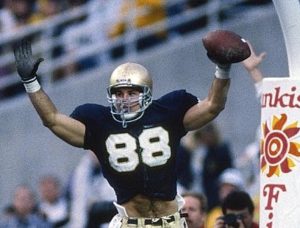
After winning the inaugural Mr. Football award in Kentucky after the 1986 season, Jacobs matriculated to Notre Dame, where he played for head coach Lou Holtz. Jacobs helped Notre Dame win the 1989 Fiesta Bowl against unbeaten West Virginia, catching a touchdown pass from Tony Rice as the Fighting Irish posted a 34-21 victory to claim the national championship. The NewCath graduate finished with four receptions during his college career, according to Notre Dame statistics, and averaged 12 yards per catch.
While Jacobs was recruited as a football player, it was baseball that elevated Jacobs into the professional ranks. After hitting .333 with 20 home runs and 79 runs batted in for Notre Dame in 1991, Jacobs was taken in the seventh round of the MLB Draft by the New York Mets. In five seasons in the minor leagues, Jacobs swatted 57 home runs and drove in 288 runs. His best season came in 1994 while playing for the Double-A Binghamton Mets, hitting 13 homers and batting .285 with 67 RBI.
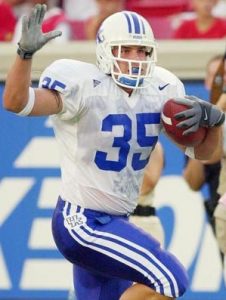
What many probably don’t remember is that fact Smith was also a highly regarded basketball recruit as well. A four-year starter at Highlands, Smith averaged 21.2 points and 7.8 rebounds per game as a senior. He finished his Highlands career with 2,299 points and 974 rebounds. Even though he was on a football scholarship at UK, Smith said then-head coach Tubby Smith twice asked him to try out for the basketball team.
Smith did indeed play college basketball, but not for UK. He instead suited up for Northern Kentucky University two years after making himself available for the NFL Draft. After hauling in 30 receptions for 396 yards and four touchdowns as a sophomore, Smith unexpectedly left UK. But the former All-Southeastern Conference tight end was not selected in the 2002 NFL Draft.
That eventually led him to NKU and first-year head coach Dave Bezold, who inserted Smith into the Norse’s starting lineup during the 2004-05 season. Ironically, Smith’s debut for NKU came during an exhibition against UK in Rupp Arena on Nov. 3, 2004. Smith finished with five points and five rebounds as UK posted a 91-73 win over NKU in front of a crowd of 18,824. The former football tight end averaged 10 points per game for the Norse in his only season of competition on the hardwood.

Lorenzen directed one of the most prolific offenses in the history of high school football that season as Highlands scored 801 points (then sixth all-time in national history) and rolled up 493.2 yards per game (then third all-time in the national record book). His favorite receiver was All-American tight end Derek Smith, giving Highlands one of the most highly recruited duos in Kentucky prep football history. In addition, Lorenzen received both the Frank Camp Award and the Roy Kidd Award as the state’s top player. He was also named Kentucky’s Mr. Football as a senior and chose Kentucky over Wisconsin and Miami (Fla.). Lorenzen started only two years at quarterback for Highlands, but he completed 351 passes in 587 attempts for 6,821 yards and 89 touchdowns.
After redshirting his first year at UK, Lorenzen became the team’s starting quarterback as a freshman. During the next four years, he threw for 10,354 yards and 78 touchdowns while adding 283 yards and 12 TDs on the ground. Lorenzen was not selected in the 2004 NFL Draft, but he signed as a free agent with the New York Giants. The “Hefty Lefty” became the backup to Eli Manning and played on the 2007 Giants team that won the Super Bowl with an upset over the previously unbeaten New England Patriots.

At the time, Kiernan was called “the most highly recruited player in Northern Kentucky history” after the likes of Alabama, Ohio State, UCLA, Purdue and Notre Dame waged recruiting wars to sign the NewCath standout. Kentucky also recruited Kiernan and actually persuaded him to sign a non-binding Southeastern Conference letter of intent, but a visit to Notre Dame’s campus changed everything. “It was just a gut feeling, and I just felt like [Notre Dame] was for me” Kiernan said in an interview with The Kentucky Post in 1981. “You can feel it all around. The atmosphere is all really good. Coach (Gerry) Faust is great. He seems to be really concerned with what I want out of my college education. The rest of the players at Notre Dame seem to really care about you, too.”
Despite a late recruiting push from UCLA, Kiernan signed with Notre Dame and developed into a solid player on the Fighting Irish defensive line. In 1985, he recorded a career-best 20 tackles during Faust’s final season as head coach at Notre Dame. Kiernan was inducted into the NewCath Hall of Fame in 2009.

Steinmetz told local media in 1997 that Wisconsin “didn’t say why, but it seemed like they over-recruited or something.” With offers from Ohio State, Michigan State, Purdue and Louisville still options, Steinmetz signed with Michigan State and then-head coach Nick Saban. He saw action in eight games as a true freshman in 1997 and recorded five solo tackles as the Spartans posted a 7-5 record, which included a trip to the Aloha Bowl. After spending a year at Michigan State, Steinmetz transferred to Kentucky and would have had three seasons of eligibility remaining with the Wildcats.

As a result of his prowess in the defensive backfield, Kremer attracted the attention of recruiters from Alabama, Ohio State Iowa, UCLA, Tennessee and Kentucky. The blue-chip football recruit was also adept on the basketball court, averaging 10 rebounds per game for the 9th Region champion Bluebirds in 1982. Kremer helped Highlands repeat as regional champions as a senior, averaging 14 points and eight rebounds per contest.
Kremer signed with Kentucky and converted to linebacker, where he enjoyed a standout career for the Wildcats. After redshirting in 1983, the Highlands graduate became a starter early in his freshman year and emerged as UK’s top defender as a senior in 1987. Kremer recorded a team-leading 180 tackles, including five for losses, during his final year. On Oct. 24, 1987, he set a then-school record with 25 total tackles in Kentucky’s 17-14 loss at Georgia. Kremer was named UK’s outstanding defensive back following the 1987 season. In 2009, Kremer was inducted into the Northern Kentucky Sports Hall of Fame.

Lynn Ray, then CovCath’s head coach, said this about Jones in 1990: “He’s the best offensive lineman we’ve ever had. He’s got it all. He runs the 40 (yard dash) in 5.1 (seconds), but I guess the thing I like about him most is the way he moves his feet for a guy his size. [College coaches] watch tapes of him for a few minutes and say, ‘I’ve seen enough. He’s going to a big-time school.’ He’s just an outstanding prospect.”
CovCath posted a 36-5 record during his three years as a varsity starter, including a 14-1 mark and the Class AAA state championship in 1988. Jones started both ways as a junior and senior, and he recorded 72 tackles with six sacks as a senior. Ray also noted that CovCath ran about 80 percent of its plays to Jones’ side of the offensive line. Twice named to the all-state team, Jones eventually selected Kentucky as his college destination. After a redshirt season, he moved from left tackle to left guard and saw action in all 11 games as a freshman. Jones moved into a permanent starting position at left guard as a junior and became a standout blocker. He was the recipient of UK’s Most Outstanding Lineman award as a junior and elected a team captain as a senior. Jones was also a member of the SEC Academic Honor Roll.
HONORABLE MENTION


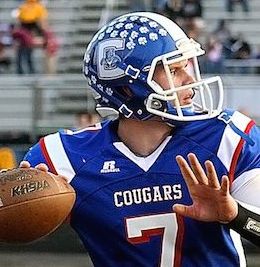

Contact NKyTribune reporter Don Owen at don@nkytrib.com and follow him on Twitter at @dontribunesport


















